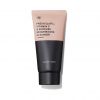Skin Care
Why Your Product's pH MattersKnow a bit of chemistry for more balanced skin |
How pH Relates to Skin Different organ systems perform best at certain pHs. When they're functioning at the optimal pH, they achieve homeostasis or stability, Heskett says. Skin has a thin, protective layer on its surface called the acid mantle. This acid mantle is made up of sebum (free fatty acids) excreted from the skin's sebaceous glands, which mix with lactic and amino acids from sweat to create the skin's pH, says skin care expert Kat Burki.
Most experts we spoke to say the ideal skin pH is slightly acidic to ward off bacteria and toxins, around 5.5. However, Heskett points out that studies have now shown that the most natural pH for skin is 4.7. "At 4.7, the skin has optimal barrier protection, moisturization and scaling," she explains. "Additionally, this pH does the best job at keeping the resident bacteria (the good bacteria) attached to the skin surface. At higher pH's this bacteria is more easily dispersed, which leaves skin unprotected."
Image via Imaxtree
SEE NEXT PAGE: Maintaining Skin's Optimal pH
Most experts we spoke to say the ideal skin pH is slightly acidic to ward off bacteria and toxins, around 5.5. However, Heskett points out that studies have now shown that the most natural pH for skin is 4.7. "At 4.7, the skin has optimal barrier protection, moisturization and scaling," she explains. "Additionally, this pH does the best job at keeping the resident bacteria (the good bacteria) attached to the skin surface. At higher pH's this bacteria is more easily dispersed, which leaves skin unprotected."
Image via Imaxtree
SEE NEXT PAGE: Maintaining Skin's Optimal pH




































